Words Posy Gentles Photographs various
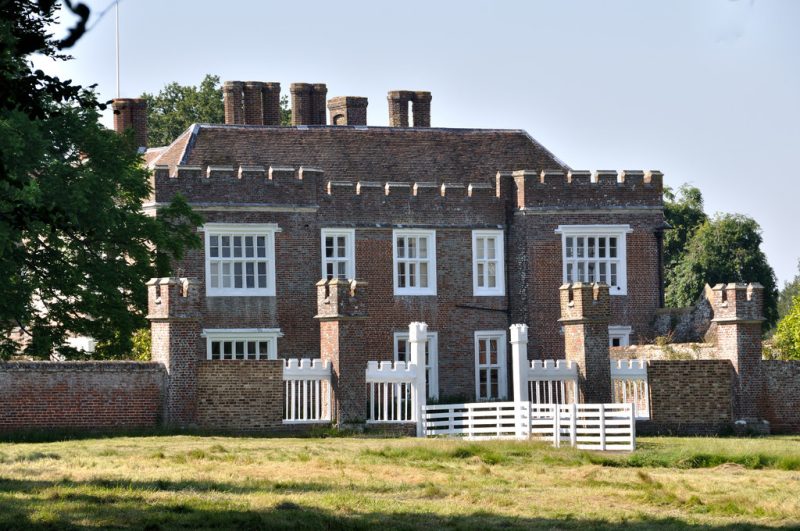
Otterden Place: Silk threads were let down from the battlements to see how far electricity could travel ©Brian Chadwick
In the summer of 1729, 23 years before Benjamin Franklin flew his kite, there were sparks flying just outside Faversham at Otterden Place. Its owner Rev Granville Wheler, and Stephen Gray, a cloth-dyer from Canterbury, had succeeded in sending an electric current from a glass tube 836 feet along a wet string supported on silk threads out of the Great Gallery window and into the grounds. The success of this experiment led the way to the development of the telegraph, the telephone and then the internet. However, Gray and Wheler did not dream of this as they experimented with the conductive properties of oak cubes, various dried leaves, a small chick and eventually a boy.
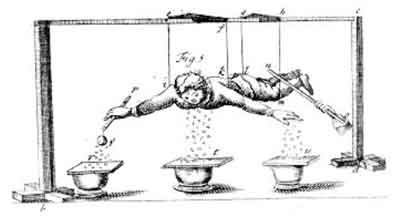
The Dangling Boy experiment

Frontispiece illustration from Essai sur l’electricité des corps by M l’abbé Nollet 1746. A boy hanging from insulating silk ropes is given an electric charge. The woman pokes the boy’s nose to get an electric shock
‘The Dangling Boy’ particularly caught the imagination of an Enlightened England. In Gray’s Philosophical Transactions (quoted in Gentleman’s Magazine and Historical Review, Vol 151), he describes the experiment, writing that, after Wheler had ‘suspended a live chick upon the tube by the legs and found that the breast was strongly electrical’, they decided to try a boy. ‘Mr Wheler procured silk lines strong enough to bear the weight of his footboy, a good stout lad; then, having suspended him upon the lines, the tube being applied to his feet and hands, and the finger of one that stood by held near his hands or face, he found himself pricked or burned as it were by a spark of fire, and a snapping noise was heard at the same time.’ A large white cockerel produced the same effect.
Gray was a pensioner at Charterhouse almshouses in Clerkenwell which also provided a school for 40 boys from poor backgrounds – presumably a good source of dangling boys – and further experiments were made, attracting scraps of brass leaf, chaff and feathers to fly up to the boy’s face.
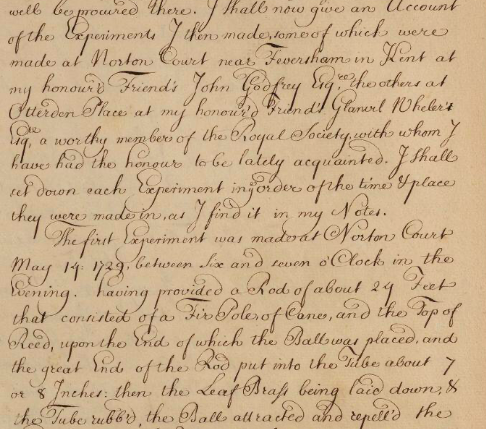
A section of Stephen Gray’s handwritten account of his experiments in Norton Court and Otterden Place
Further night time experimentation at Otterden Place showed that the electricity produced light. Gray writes: ‘At night we made the luminous part of the experiment, suspending the iron rod on the silk lines, then applying one end of the tube to one end of the rod, not only that end had a light upon it, but there proceeded a light at the same time from the other, extending in form of a cone whose vertex was at the end of the rod. We could see plainly that it consisted of threads or rays of light diverging from the pores of the rod, and the exterior rays being incurvated. This light is attended by a small hissing noise.’ In concluding his paper, Gray wrote: ‘Although these effects are but in minimis, it is probable in time there may be found out a way to collect a greater quantity of it, and consequently to increase the force of this electric fire.’ A light bulb moment indeed!
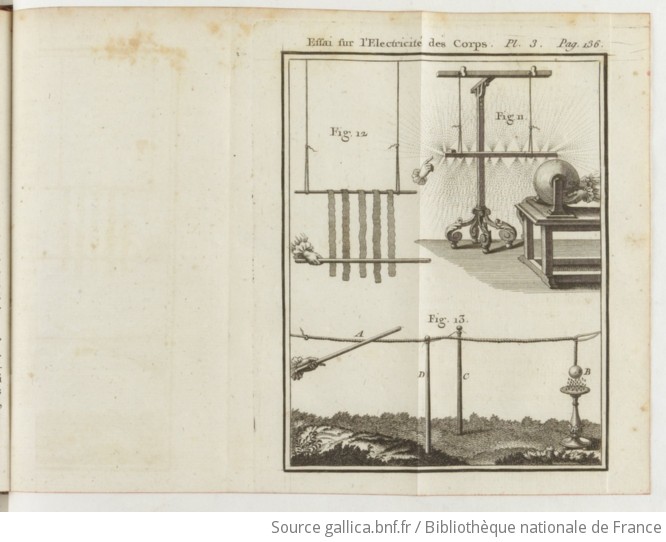
The diagram shows how the silken thread was led out into the grounds of Otterden Place – note the planting and birdbath. (Antoine Nollet, Essai sur l’electricité des corps (Paris, 1746). Wellcome Library Photo number: M0014506. Copyrighted work available under Creative Commons Attribution only licence)
The phenomena of electricity had been recognised for centuries: Pliny the Elder described the shock of touching electric fish, and it had long been known that if amber was rubbed with soft fur, it would attract light objects. In 1600, the English scientist William Gilbert wrote De Magnete, a study of electricity and magnetism, and coined the word electricus from the Greek word elektron meaning amber. The 17th and 18th centuries saw the development of a new rational and empirical approach to scientific study.
Stephen Gray was the first to understand the difference between conductors and insulators, and to demonstrate that electricity could be transmitted over long distances. Yet, even in his lifetime, he struggled to gain recognition for his work. Science was a rich man’s game in this era and Gray was not wealthy. He was born in Canterbury in 1666 and went into the family cloth-dyeing trade, working on his scientific studies and experiments in any spare moment. Nonetheless, he managed to educate himself through wealthy friends in the area such as Rev Granville Wheler at Otterden Place, who became a member of the Royal Society thanks to his work with Gray, and John Godfrey of Norton Court – both of whom were involved in the experiments of 1729.
Some of Gray’s early reports on sunspots (which he discovered by grinding his own lenses and constructing a telescope) were published by the Royal Society with the help of his friend Henry Hunt, a member of the Society’s secretarial staff. They attracted the notice of John Flamsteed, the first Astronomer Royal who was building the new Royal Greenwich Observatory, and was the uncle of John Godfrey of Norton Court. Gray worked with some of the most important scientists of the day but was evidently rarely paid and eventually slipped into poverty. In 1720, helped by Flamsteed and Sir Hans Sloane, he obtained a pensioned position at the Charterhouse in Clerkenwell to continue his work with electricity.
There was a suggestion that the Royal Society had denied him recognition because Isaac Newton, the president until his death in 1727, was hostile to Gray because of his links with Flamsteed with whom Newton was frequently in opposition, but it seems more likely that electricity just wasn’t considered that important at the time. Gray was not a member of the Royal Society as he was too poor to pay the dues and much of his research was absorbed into the work of those he assisted.
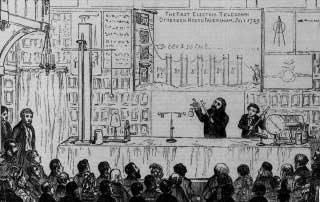
A lecture at the Charterhouse on discoveries in electricity by Stephen Gray. The diagram above the speaker shows the first electric telegraph at Otterden Place, Faversham July 1729
It was only when Gray’s friend and financial supporter, Sir Hans Sloane became president after Newton’s death, that his work was recognised. He was awarded the Society’s first Copley Medal, the most prestigious award of the Royal Society, conferred for ‘sustained outstanding achievements in any field of science’, for his work on conduction and insulation, and also the second Copley Medal in 1732 for his induction experiments. Gray was admitted to the Royal Society finally in 1732 as an honorary member but sadly enjoyed it only briefly. Years of poor health and poverty brought about his death in 1736. He died destitute and is probably buried in a common grave in London.
His achievements remained largely forgotten, overshadowed by subsequent discoveries, until in 2017 the School of Physical Sciences at the University of Kent established the Stephen Gray Lectures in his memory.
Text: Posy Gentles. Photographs: As attributed and various
Static Electricity Experiments to Try at Home (Dangling Boy not advised) from the Charterhouse website
Flying confetti: Empty the circles of paper from a hole punch. Rub a plastic ruler on a soft cloth or your jumper. Hover the ruler over the confetti and see the paper rise.
Follow-my-leader: Take an empty tin can and place on a smooth surface. Rub your ruler with a piece of cloth for 40 seconds. Place the cloth near but not touching the can. Place the ruler on the other side of the can. Move the ruler and the can will follow.
Bendy water: Rub the ruler on your jumper for 40 seconds. Place it near a stream of water from a tap. The water will bend away from the ruler.